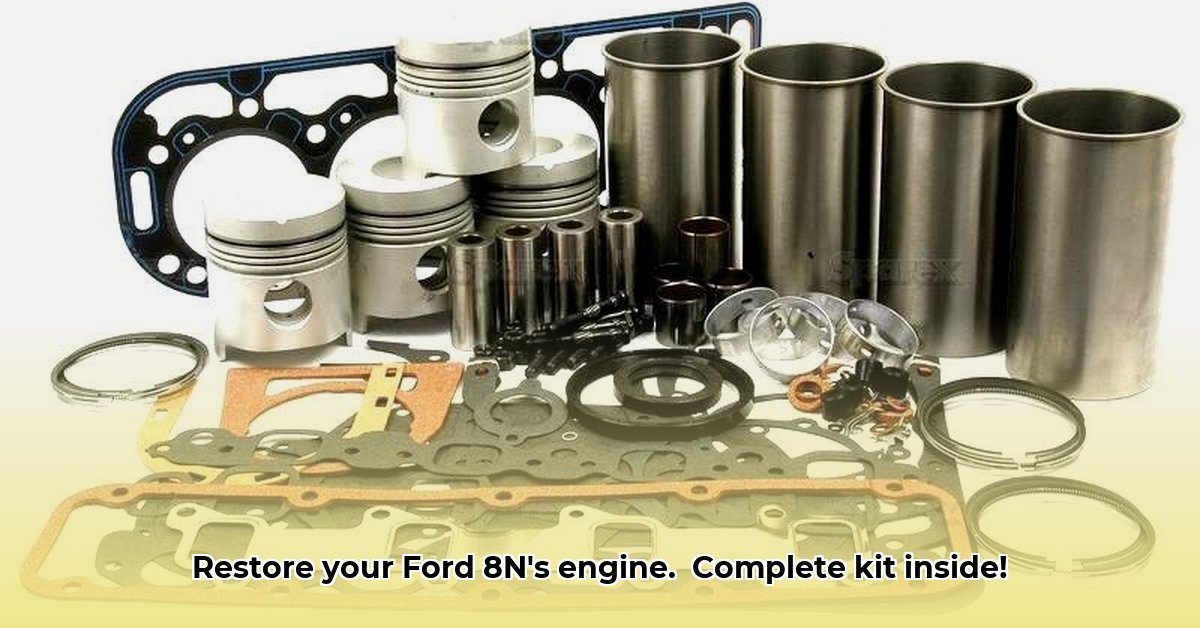
Reviving your Ford 8N tractor's engine is achievable with the right approach. This guide navigates you through choosing and installing the correct rebuild kit, ensuring a successful overhaul. Whether you're a seasoned mechanic or a weekend DIY enthusiast, we'll equip you to get your 8N running smoothly again. For more information on maintaining your 8N, check out these helpful resources.
Assessing Your Engine: A Critical First Step
Before selecting a rebuild kit, a thorough engine inspection is crucial. This determines whether you need a simple in-frame overhaul or a complete rebuild. Carefully examine the cylinder walls for scoring or excessive wear, the bore for significant wear, and the pistons for damage.
Key areas for inspection:
- Cylinder Walls: Look for scoring or excessive wear, indicating the need for more extensive repair involving cylinder sleeving or honing.
- Piston Condition: Evaluate for wear, scoring, or cracks. Significant wear requires piston replacement.
- Rotating Valve System: Confirm whether your 8N incorporates a rotating exhaust valve system. This influences required part selection—specifically, parts like the 8N6505C exhaust valves and 8N6534B Valve Rotor Assembly are essential if your engine utilizes a rotating valve system.
Choosing the Right 8n Ford Tractor Engine Rebuild Kit
Numerous suppliers offer 8N engine rebuild kits, varying in components and price. Typical kits include pistons, rings, piston pins, retainers, and gasket sets. However, key differences exist:
- Sleeve Thickness: Common sizes include .040" and .090". The correct size depends on the level of cylinder wear.
- Piston Rings: Kits may include 3 or 4 piston rings per piston. The number often depends on the type of kit (basic or comprehensive).
- Included Components: Some kits bundle additional parts like timing gears, hoses, or even carburetor rebuild kits.
Crucially, most kits do not include bearings. You must source these separately, using the specifications provided by your kit supplier. Incorrect bearings can lead to catastrophic engine failure.
| Kit Type | Sleeve Thickness | Piston Rings | Included Components | Bearing Information | Notes |
|---|---|---|---|---|---|
| Basic In-Frame Overhaul | .040" | 3 | Pistons, rings, gaskets, basic pin bushings | Contact supplier | Suitable for minor repairs, addressing wear and tear on specific components. |
| Comprehensive Engine Rebuild | .090" | 4 | Pistons, rings, gaskets, pin bushings, more | Contact supplier | Necessary for major overhauls requiring extensive part replacement. |
| Custom/Specialized Kit | Varies | Varies | Varies (tailored to specific needs) | Contact supplier | Allows selection of precise components, customizing the repair to your engine's needs. |
The Rebuild Process: A Phased Approach
A fully detailed step-by-step guide is beyond this article; however, a breakdown into key phases is provided:
Phase 1: Disassembly: Methodically disassemble the engine, carefully labeling and bagging each part. Photography at each step is invaluable.
Phase 2: Inspection and Cleaning: Thoroughly inspect each component for damage. Clean all parts using appropriate cleaning agents.
Phase 3: Part Replacement and Machining: Install the new parts. Professional machining services might be necessary, depending on the level of wear.
Phase 4: Reassembly: Carefully reassemble the engine, adhering to torque specifications (as outlined in your service manual).
Phase 5: Testing and Fine-Tuning: After reassembly, run the engine, monitoring its operation for unusual sounds or vibrations.
Have you considered using a torque wrench to ensure consistent and accurate tightening during reassembly? This is essential for proper function and extended engine life.
Troubleshooting and Preventative Maintenance
During the rebuild process, consult your workshop manual. Online forums and communities dedicated to Ford 8N tractors are also invaluable resources. Regular oil changes, filter replacements, and inspections are critical for longevity.
Sourcing Parts and Additional Resources
While your kit supplier is a good starting point, explore other reputable sources, such as local agricultural equipment shops. Never compromise on part quality.
Key Considerations for Choosing the Right Kit
- Pre-assembly inspection: Thoroughly inspect the condition of piston rings. Damage at this stage can lead to significant issues later on.
- In-frame vs. full rebuild: Choosing the right kit depends on the extent of the damage to your tractor's engine.
- Bearing selection: Always verify that the kit includes appropriate bearings. If not, source them separately from a reputable supplier.